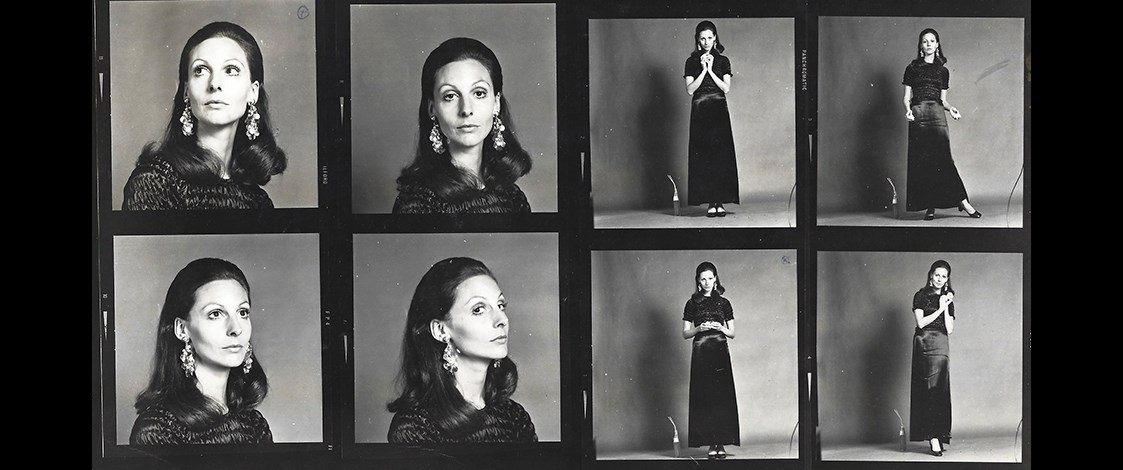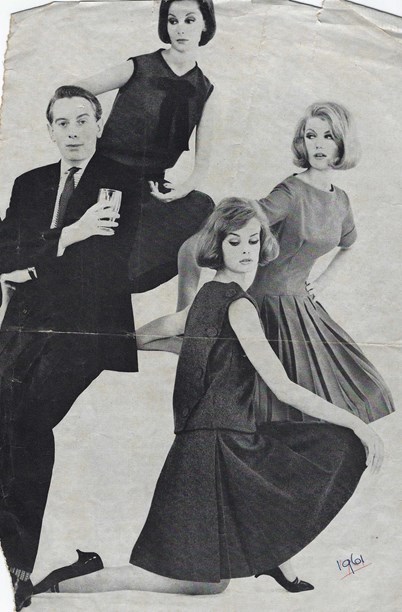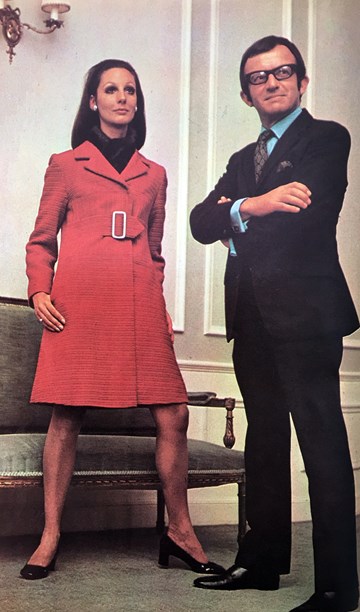Stories
Anne McClurg

Anne McClurg modelled for top UK and European designers in the late 1950s and the early 'swinging sixties'. She appeared on the covers and pages of Vogue, Harpers, Queens, Women’s Wear Daily and Vanity Fair and in New Zealand become one of the best known faces in the modelling world in a career that stretched from 1957 to 1984.
Born in Shropshire, England, Anne dreamed of becoming a ballet dancer. She studied for 12 years at England’s prestigious Elmhurst Ballet School, now the English National Ballet School, but an ankle injury at 15 ended those dreams.
Anne decided to try her luck as a model, seeking out a top London agency where she was told (at five feet, seven inches – 170 cm) "Forget it! You’re not tall enough." Undeterred she found another agent and her first job as a house model for a London blouse and skirt manufacturer. This was followed by a stint as house model for the couturier known simply as 'Mr Michael'. Mr Michael was in fact Irish born Michael Donnellan, one of the first designers in the 1950s to develop the 'three-piece model' of jacket, skirt and tailored matching blouse and considered by some as 'the Balenciaga of London'.
A year or so later, Anne decided to try her luck as a freelancer and cheekily rang all the fashion houses that she wanted to work for. She also successfully approached London’s top agent, Michael Whittaker, who was staging most of the big fashion events of the time, like the London Fashion Week shows. Anne began doing major shows and photographic assignments in the UK and Europe and even the United States.
By 1957 English fashion was in transition, spearheaded by Mary Quant, the designer who writer David Wills in his book, Switched on: Women who revolutionised style in the '60s says most changed the 'fashion conversation'.
"You still had clothes and attitudes that reflected a much more stable, traditional outlook," Anne says. "But as we moved into the sixties there was this huge emphasis on everything 'young'. As a model you had an interesting contrast between the very stately, regal, toffee-nosed haute couture shows and wonderful new ones that were full of dancing, liveliness and heaps of fun for someone who was young."
One of the funniest shows for Anne was a Mary Quant opening. In her autobiography Quant on Quant Mary writes: "We were showing knee-high cowboy boots worn with fantastically short skirts; high-waisted tweed tunic suits with tweed knickerbockers; Norfolk jackets trimmed lavishly with fox collars. Eyebrows went right up to the hairline when the first model appeared. One girl carried an enormous shotgun; another swung a dead pheasant triumphantly round her head. Perhaps too triumphantly because the poor thing, which we had bought from Harrods across the road, thawed out in the heat of the place and blood began spurting out all over the newly painted walls; even over some of the journalists."
And the girl with the dead pheasant? Anne laughs. "Well it was swinging London!"
Anne remembers the 'Sixties Revolution' fashion upsurge as "a huge blossoming of youth that wouldn’t be sat on". And she was at the centre of it, along with models like Jean Shrimpton. Vidal Sassoon did her hair and she worked with photographers Norman Parkinson, the young David Bailey, and John French.
"John was the first really great photographer I worked with," Anne recalls. "He told me to always treat the camera as if it were a person. And it worked. React to the camera as if you were speaking to it. As if it were someone’s face."
"Every girl who got to the top had something unique. In my case, I think it was a combination being able to move well and act, which came from my ballet training. This made me very adaptable and I could easily make the transition from formal and traditional to the much less formal and fun."

Anne McClurg (top) in a photoshoot with Kenneth Tynan, Jean Shrimpton and Christiana Bailey from British Vogue, late 1950s. Image © The Condé Nast Publications Ltd.
"I also benefited enormously from workmates like Bronwen Pugh (later Viscountess Astor) and Fiona Campbell-Walter (later Baroness Thyssen). They were at the top of their careers when I was starting out and very good about sharing crucial little things that would have taken years of experience to learn. The editor of Women’s Wear Daily once said that Bronwen dragged her fur coat down the runway as if she’d killed it and was taking it home to her mate. Bronwen taught me that way of being very casual and treating mink like it was a piece of old floor cloth. She also taught me how to walk from the hips and not the knees, which gives you a very long, loping sort of stride."
While Anne mixed with the 'beautiful people' and was presented to the Queen and other royals, social life for the 'model girls' as they were known, was quiet.
"It mattered if you partied hard because it showed on your face. Photographic models couldn’t afford to look anything but fresh and a typical work day would start at 7:15am and go to seven or ten at night."
In 1961 just before she was scheduled to be on the cover of Vogue’s coveted Christmas edition, love intervened. Anne married Kiwi Bassett McClurg and headed for Auckland, New Zealand, where, a year after she’d had the first of her three children, she once again found herself in demand as a model.
"Paddy Walker had heard about me and invited me to work for her in her shows. Known for her balletic elegance on the catwalk Anne always had a preference for parades over photographic work."
"It’s an enchanting thing to put on a piece of clothing and see what it makes you feel like. Does it make you feel romantic or sporty or is it sophisticated? You can act all this out through the gear which you can’t really do when you’re doing the Victorian faint in front of the camera!"
Photos of Anne McClurg by Michael Gillies dominated Vogue New Zealand's Spring 1963 issue. Image © The Condé Nast Publications Ltd
It was Paddy Walker who introduced Anne to photographer, Michael Gillies. Despite Anne’s preference for the catwalk, she and Gillies established a longstanding working partnership for many memorable fashion shoots. A notable example was Vogue New Zealand’s Spring 1963 issue; the first time that Australia-based editor Sheila Scotter had commissioned entirely New Zealand content for the magazine, with Michael’s photographs of Anne on the cover and featured throughout.
Then there was Anne’s association with El Jay and the legendary Gus Fisher. "Anne McClurg’s poise and drama had taken the local modelling scene by storm – upping the ante for all those who were photographed alongside her," writes Claire Regnault in The Dress Circle. "She quickly secured a position as El Jay’s house model."

Anne McClurg and Gus Fisher were photographed for Thursday magazine in 1969. Image © Thursday.
Anne was to model for El Jay’s summer and winter collections from 1962 – 1985. These collection shows for retail store buyers were modelled on Dior’s Paris atelier showings and held twice a day for two weeks.
"When you walked into the showroom, you knew you looked a million dollars – you couldn’t help it," Anne commented in a New Zealand Fashion Museum article.
She loved working with 'Gussy' as she affectionately calls Fisher. "As we got to know each other he would let me more into the inside. I would go in three months before the collection was due and try on the new toiles. Eventually he’d allow me to have a say in choosing the fabrics. He’d wrap me in gorgeous things and say 'go to the mirror and see how that looks.'"
When it came to the finishing touches, she recalls 'doing the lengths'. "You would stand on a table for hours while people went round you with chalk and pins. What a day! Everything had to be perfect. Gus had been known literally on the day of the collection to say, 'I want those buttons moved one eighth' and there were five of them. They’d have to cut a whole new front. But he was always right – he had this incredible eye for proportion and how things like button placement could affect how a woman looked in a garment."
For someone who has worn some of the fashion world’s most exclusive garments, Anne says she’s always seen herself as more of a 'jeans and t-shirt' kind of girl. There are few souvenirs from her lengthy career in her current wardrobe but there is one Gus Fisher dress that she loves and can still "just about" wear. "It’s the most beautiful coral colour trimmed with amethyst and it’s washable – a lovely easy dress."
Text by Bob Feigel and Katherine Findlay.
Last published February 2019.